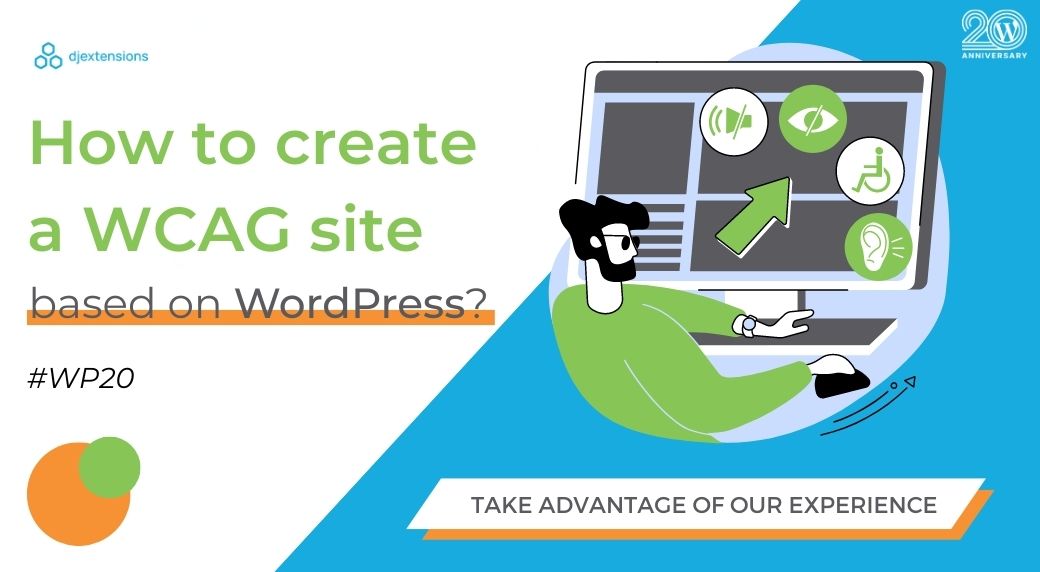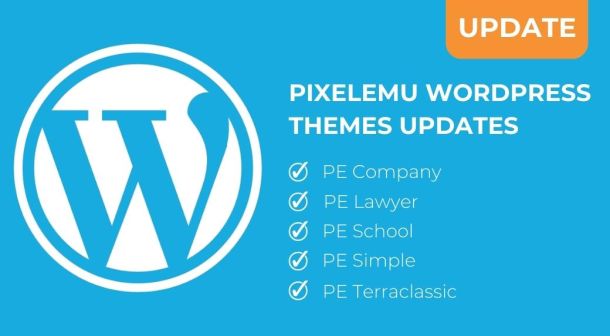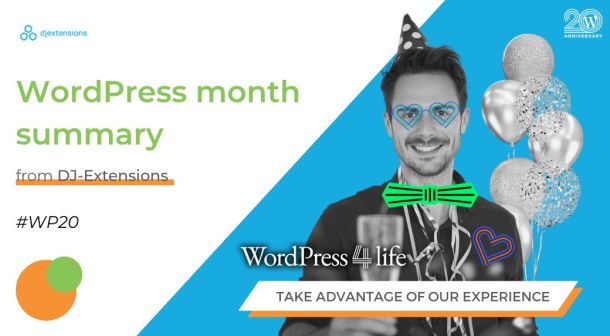
How to create a WCAG website based on WordPress?
In today's digital age, web accessibility has become an increasingly important topic. Websites are often the primary source of information and communication for people, and it's essential that they are accessible to everyone, regardless of their abilities. Web Content Accessibility Guidelines (WCAG) are a set of guidelines created by the World Wide Web Consortium (W3C) to help ensure that websites are accessible to people with disabilities.
WCAG guidelines are designed to ensure that websites are perceivable, operable, understandable, and robust. It means that websites should be designed to accommodate people with a range of disabilities, including visual, auditory, physical, and cognitive disabilities.
WordPress is a popular platform for creating websites, and it can be used to create accessible websites that comply with WCAG guidelines. In this blog post, we will explore how to create a WCAG site based on WordPress, including how to choose an accessible theme, optimize WordPress plugins, improve accessibility in WordPress content, and test for accessibility.
Understanding WCAG guidelines
WCAG guidelines are divided into three levels of conformance: A, AA, and AAA. Level A includes the minimum requirements for accessibility, while AA includes additional guidelines to improve accessibility, and AAA includes the highest level of accessibility.WCAG guidelines are based on four principles: Perceivable, Operable, Understandable, and Robust. Each principle includes a set of guidelines that help ensure that websites are accessible to people with disabilities.
- Perceivable: Websites should provide content that can be perceived by people with a range of disabilities. This includes providing alternative text for images and videos, providing captions and transcripts for audio content, and ensuring that color is not the only means of conveying information.
- Operable: Websites should be designed to be operable by people with disabilities. This includes providing keyboard access for navigation, ensuring that there is enough time to interact with content, and avoiding content that can cause seizures or physical reactions.
- Understandable: Websites should be designed to be understandable by people with disabilities. This includes using clear and simple language, providing instructions and feedback, and avoiding content that is difficult to understand.
- Robust: Websites should be designed to be robust and compatible with a range of assistive technologies. It includes using proper HTML markup, ensuring that content is accessible through different devices and platforms, and avoiding technologies that are known to cause accessibility issues.
Each WCAG guideline can be applied to WordPress websites by selecting an accessible theme, using accessible plugins, optimizing images and videos for accessibility, using proper HTML structure and headings, and testing for accessibility using automated tools and manual testing.
By understanding the WCAG guidelines and applying them to your WordPress website, you can ensure that your website is accessible to people with disabilities and provide a positive user experience for all visitors.
Choosing an accessible WordPress theme
Choosing an accessible WordPress theme is crucial for ensuring that your website is accessible to everyone. An accessible theme should provide a good contrast ratio between the text and the background, use proper headings and semantic HTML, and be compatible with assistive technologies such as screen readers.
To identify an accessible WordPress theme, you can look for themes that comply with the WCAG guidelines, have been tested for accessibility, and have accessibility features built-in. Some of the features to look for include keyboard navigation, alternative text for images, and support for assistive technologies such as screen readers.
There are many accessible WordPress themes available that you can use for your website. Here are a few examples:
- DJ-University - the accessible education website Quickstart for WordPress, based on YOOtheme Pro web builder. It's a modern, WCAG solution, perfect for educational websites, including schools, universities, and kindergartens.
- DJ-Commune - Ready to use WordPress portal , comprehensive WCAG-compliant, and YOOtheme Pro web builder. Perfect for municipal offices, public organizations and government institutions.
- DJ-PublicServices - a WCAG solution perfect for a municipal office, public organizations, or government institutions portal. The theme can be easily adapted to any thematic category of your choice.
By choosing an accessible WordPress theme, you can ensure that your website is accessible to everyone, regardless of their abilities, and provide a positive user experience for all visitors.
Optimizing WordPress plugins for accessibility
Using accessible plugins is essential for ensuring that your WordPress website is accessible to everyone. Plugins can add functionality and features to your website, but they can also introduce accessibility issues if they are not designed with accessibility in mind.
To identify accessible plugins for your website, you can look for plugins that comply with the WCAG guidelines, have been tested for accessibility, and have accessibility features built-in. Some of the features to look for include keyboard navigation, alternative text for images, and support for assistive technologies such as screen readers.
Here are some examples of accessible WordPress plugins:
- DJ-Accessibility: The accessibility plugin for WordPress, working as a standalone tool, but also integrated with YOOtheme Pro web builder. This plugin is a toolkit for WordPress, that makes the website easier to navigate for people with disabilities. Use its options to improve the website's user experience.
- DJ-WCAG-Improvement: a WordPress plugin dedicated to the YOOtheme web builder. It adds an aria-label for 12 YOOtheme elements (button, grid, icon, overlay-slider, pagination, panel, panel-slider, popover, slideshow, social, switcher, to top).
By using accessible plugins on your WordPress website, you can ensure that all visitors can access the content and functionality of your website, regardless of their abilities.
Improving accessibility in WordPress content
Optimizing images, videos, and other media for accessibility is essential for ensuring that your WordPress website is accessible to everyone. Here are some tips for optimizing media for accessibility:
- Images: Use alternative text (alt text) to describe the content of images for people who cannot see them. Write descriptive alt text that provides context and conveys the purpose of the image.
- Videos: Provide captions or transcripts for videos to make them accessible to people who are deaf or hard of hearing. Captions should be synchronized with the audio and identify who is speaking.
- Other Media: Use appropriate headings and labels for other media such as audio files and PDF documents. Make sure that the content of these files is accessible and can be read by assistive technologies.
Using proper HTML structure and headings is also essential for improving accessibility in WordPress content. Here are some tips for using proper HTML structure:
- Use headings to structure your content: Use heading tags (H1, H2, H3, etc.) to create a hierarchical structure for your content. This makes it easier for users to navigate your website and understand the content.
- Use semantic HTML: Use semantic HTML tags to provide meaning and context to your content. For example, use the <nav> tag for navigation menus and the <article> tag for articles.
- Use lists: Use ordered or unordered lists to organize content such as instructions, steps, or bullet points. This makes it easier for users to understand and follow the content.
Writing accessible content is also important for improving the accessibility of your WordPress website. Here are some tips for writing accessible content:
- Use simple language: Use simple and clear language to make your content easier to understand for everyone, including non-native speakers and people with cognitive disabilities.
- Provide descriptive links: Use descriptive link text that provides context and conveys the purpose of the link. Avoid using phrases such as "click here" or "read more."
- Use color contrast: Use a high contrast between the text and background to make your content easier to read for everyone, including people with low vision or color blindness.
By optimizing media, using proper HTML structure and headings, and writing accessible content, you can improve the accessibility of your WordPress website and provide a positive user experience for all visitors.
Testing for accessibility
Testing your website for accessibility is an essential part of creating an accessible WordPress site. Here are some ways to test your website for accessibility:
- Automated Accessibility Testing Tools: There are several automated accessibility testing tools available that can scan your website for accessibility issues. These tools check your website for compliance with the WCAG guidelines and provide a report of any accessibility issues found. Some examples of automated accessibility testing tools include Axe, WAVE, and Siteimprove.
- Manual Accessibility Testing: While automated testing tools can help identify some accessibility issues, they cannot identify all accessibility issues. Manual accessibility testing is necessary to identify issues that cannot be detected by automated tools. Manual testing involves using assistive technologies such as screen readers and keyboard-only navigation to test your website's accessibility.
It is important to test your website for accessibility because it ensures that your website is usable by everyone, including people with disabilities. It also helps to identify and fix accessibility issues before they impact your website's usability and reputation.
Automated accessibility testing tools and manual accessibility testing are both important for testing the accessibility of your WordPress website. By testing your website for accessibility, you can identify and fix any accessibility issues and ensure that your website is accessible to everyone.
Conclusion
In conclusion, creating an accessible website using WordPress is essential for ensuring that your website is usable by everyone, including people with disabilities.
It's important to emphasize that creating an accessible website is not only the right thing to do, but it's also required by law in many countries. By creating an accessible website, you are opening your business or organization to a wider audience and demonstrating a commitment to inclusivity.
By prioritizing accessibility in your WordPress website, you can ensure that your website is usable by everyone and that your content is accessible to all.


